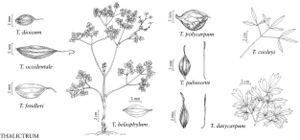Difference between revisions of "Thalictrum pubescens"
Fl. Amer. Sept. 2: 388. 1814, not T. pubescens Schleicher ex de Candolle 1817.
FNA>Volume Importer |
FNA>Volume Importer |
||
| Line 20: | Line 20: | ||
|basionyms= | |basionyms= | ||
|synonyms={{Treatment/ID/Synonym | |synonyms={{Treatment/ID/Synonym | ||
| − | |name= | + | |name=Thalictrum carolinianum var. subpubescens |
|authority=de Candolle | |authority=de Candolle | ||
| − | }}{{Treatment/ID/Synonym | + | }} {{Treatment/ID/Synonym |
| − | |name= | + | |name=Thalictrum polygamum |
|authority=Muhlenberg ex Sprengel | |authority=Muhlenberg ex Sprengel | ||
| − | }}{{Treatment/ID/Synonym | + | }} {{Treatment/ID/Synonym |
| − | |name= | + | |name=Thalictrum polygamum var. hebecarpum |
|authority=Fernald | |authority=Fernald | ||
| − | }}{{Treatment/ID/Synonym | + | }} {{Treatment/ID/Synonym |
| − | |name= | + | |name=Thalictrum polygamum var. intermedium |
|authority=B. Boivin | |authority=B. Boivin | ||
| − | }}{{Treatment/ID/Synonym | + | }} {{Treatment/ID/Synonym |
| − | |name= | + | |name=Thalictrum polygamum var. pubescens |
|authority=(Pursh) K. C. Davis | |authority=(Pursh) K. C. Davis | ||
| − | }}{{Treatment/ID/Synonym | + | }} {{Treatment/ID/Synonym |
| − | |name= | + | |name=Thalictrum pubescens var. hebecarpum |
|authority=(Fernald) B. Boivin | |authority=(Fernald) B. Boivin | ||
}} | }} | ||
| Line 53: | Line 53: | ||
|distribution=St. Pierre and Miquelon;N.B.;Nfld.;N.S.;Ont.;P.E.I.;Que.;Ala.;Ark.;Conn.;Del.;D.C.;Ga.;Ill.;Ind.;Ky.;Maine;Md.;Mass.;Mich.;Miss.;N.H.;N.J.;N.Y.;N.C.;Ohio;Pa.;R.I.;S.C.;Tenn.;Vt.;Va.;W.Va. | |distribution=St. Pierre and Miquelon;N.B.;Nfld.;N.S.;Ont.;P.E.I.;Que.;Ala.;Ark.;Conn.;Del.;D.C.;Ga.;Ill.;Ind.;Ky.;Maine;Md.;Mass.;Mich.;Miss.;N.H.;N.J.;N.Y.;N.C.;Ohio;Pa.;R.I.;S.C.;Tenn.;Vt.;Va.;W.Va. | ||
|discussion=<p>The ovaries change from white to purplish, becoming light green, then darker green, and finally brown as fruits mature.</p><!-- | |discussion=<p>The ovaries change from white to purplish, becoming light green, then darker green, and finally brown as fruits mature.</p><!-- | ||
| − | --><p>Because of the polymorphic nature of Thalictrum pubescens, a proliferation of names for minor morphologic variants has resulted. Field studies (M. Park 1992) have shown that too much morphologic variation occurs within populations to support the recognition of previously described taxa. Plants in New England and northeastern Canada often have a corymbose inflorescence and longer filaments and achene beaks.</p><!-- | + | --><p>Because of the polymorphic nature of <i>Thalictrum pubescens</i>, a proliferation of names for minor morphologic variants has resulted. Field studies (M. Park 1992) have shown that too much morphologic variation occurs within populations to support the recognition of previously described taxa. Plants in New England and northeastern Canada often have a corymbose inflorescence and longer filaments and achene beaks.</p><!-- |
--><p>This species is often incorrectly treated in floras as T. polygamum Sprengel, an invalid name.</p><!-- | --><p>This species is often incorrectly treated in floras as T. polygamum Sprengel, an invalid name.</p><!-- | ||
| − | --><p>The Iroquois used Thalictrum pubescens medicinally a a wash for head and neck, to stop nosebleeds, and to treat gall (D. E. Moerman 1986).</p> | + | --><p>The Iroquois used <i>Thalictrum pubescens</i> medicinally a a wash for head and neck, to stop nosebleeds, and to treat gall (D. E. Moerman 1986).</p> |
|tables= | |tables= | ||
|references= | |references= | ||
| Line 68: | Line 68: | ||
|rank=species | |rank=species | ||
|parent rank=section | |parent rank=section | ||
| − | |synonyms= | + | |synonyms=Thalictrum carolinianum var. subpubescens;Thalictrum polygamum;Thalictrum polygamum var. hebecarpum;Thalictrum polygamum var. intermedium;Thalictrum polygamum var. pubescens;Thalictrum pubescens var. hebecarpum |
|basionyms= | |basionyms= | ||
|family=Ranunculaceae | |family=Ranunculaceae | ||
| Line 79: | Line 79: | ||
|publication year=1817 | |publication year=1817 | ||
|special status=Endemic;Selected by author to be illustrated;Weedy | |special status=Endemic;Selected by author to be illustrated;Weedy | ||
| − | |source xml=https://jpend@bitbucket.org/aafc-mbb/fna-data-curation.git/src/ | + | |source xml=https://jpend@bitbucket.org/aafc-mbb/fna-data-curation.git/src/8f726806613d60c220dc4493de13607dd3150896/coarse_grained_fna_xml/V3/V3_799.xml |
|genus=Thalictrum | |genus=Thalictrum | ||
|section=Thalictrum sect. Leucocoma | |section=Thalictrum sect. Leucocoma | ||
Revision as of 17:20, 18 September 2019
Stems erect, coarse, 50-300 cm. Leaves basal and cauline; basal and proximal cauline leaves petiolate, distal cauline sessile; petioles and rachises frequently pubescent. Leaf blade ternately and pinnately decompound; leaflets light to dark green, cordate or nearly orbiculate to ovate or obovate, apically undivided to 2-3(-5)-lobed or -toothed, 11-68 × 5-70 mm, length 0.8-2.6 times width, membranous to firm, margins scarcely revolute, lobe margins entire, surfaces abaxially pubescent to glabrous. Inflorescences racemes or panicles to corymbs, apically ± rounded, many flowered; peduncles and pedicels often pubescent. Flowers unisexual or bisexual (sometimes bisexual with very few stamens); sepals 4(-6), white to purplish, elliptic-rounded, 2-3.5 mm; filaments ascending, white to purplish, filiform to distinctly clavate, 1.5-7 mm, usually rigid; anthers 0.5-1.5(-2.1) mm, usually blunt or only slightly apiculate. Achenes numerous, sessile to stipitate; stipe 0.5-1.5(-2.4) mm; body ellipsoid, 3-5 mm, prominently veined, usually pubescent; beak usually persistent, straight or coiled distally, 0.6-2.5 mm, about 1/2 length of achene body. 2n = 126.
Phenology: Flowering late spring–summer (mid Jun-early Aug).
Habitat: Full sun to deep shade, rich woods, low thickets, swamps, wet meadows, and stream banks
Elevation: 15-1500 m
Distribution
St. Pierre and Miquelon, N.B., Nfld., N.S., Ont., P.E.I., Que., Ala., Ark., Conn., Del., D.C., Ga., Ill., Ind., Ky., Maine, Md., Mass., Mich., Miss., N.H., N.J., N.Y., N.C., Ohio, Pa., R.I., S.C., Tenn., Vt., Va., W.Va.
Discussion
The ovaries change from white to purplish, becoming light green, then darker green, and finally brown as fruits mature.
Because of the polymorphic nature of Thalictrum pubescens, a proliferation of names for minor morphologic variants has resulted. Field studies (M. Park 1992) have shown that too much morphologic variation occurs within populations to support the recognition of previously described taxa. Plants in New England and northeastern Canada often have a corymbose inflorescence and longer filaments and achene beaks.
This species is often incorrectly treated in floras as T. polygamum Sprengel, an invalid name.
The Iroquois used Thalictrum pubescens medicinally a a wash for head and neck, to stop nosebleeds, and to treat gall (D. E. Moerman 1986).
Selected References
None.
